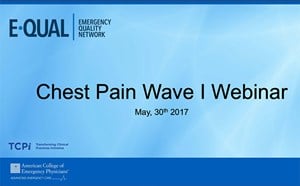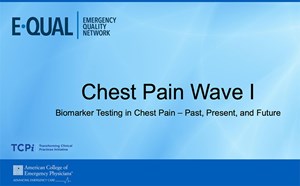Read the Full Transcript
- [Greg] Welcome to another lecture in ACEP's quality measures series, and thanks for your interest. My name is Greg Miller. I'm an emergency physician in Washington State and I serve on ACEP's Quality and Patient Safety Committee. I'm gonna be talking about claims-based measures and electronic clinical quality measures. There are several different types of quality measures. They differ in how data is collected, how it's abstracted, and how it's reported. We're going to focus this lecture on claims-based quality measures, which can be either reported directly through claims or in a sense, human abstracted and then reported. We're also going to focus on electronic clinical quality measures or EQMs. We're not going to talk about other types of quality measures, such as CMS web interface measures, the Consumer Assessment of Healthcare Providers and Systems, or CAHPS measures or administrative claims measures. Let's start by talking about claims-based measures, specifically claims-based measures that are directly reported through the claims process. An example might be a readmissions measure. To calculate this measure, you just need standard hospital claims to report the data used to calculate the quality measure. You can look at patients, such as Medicare fee for service enrollees who have a specific diagnosis on the claim, such as an acute myocardial infarction, and were admitted now and also admitted at some point in the last 30 days. You don't need a human abstracter to look at the chart and figure out whether inclusion or exclusion criteria were met. You don't need the physician to do any special documentation. You don't need to set up a data feed with the EHR to automatically calculate any results. All you need are the claims themselves, and you can directly report this type of measure. Another type of claims-based measure is basically human-abstracted measures. These measures aren't directly claims-based measures. They're not directly reported from claims, but often, the building or revenue cycle management and claims process is involved to generate the data for the measure. An example might be using head CTs and blunt head trauma. To calculate this measure, you need someone in your hospital's quality department or in your revenue cycle management company to actually sit down with a patient chart and abstract it. They'll look for specific inclusion or exclusion criteria, such as whether the patient had a seizure or is on anticoagulation. This type of data can't be found directly on the claims form, and it requires human abstracters to figure it out. It also requires physicians to learn to document certain inclusion and exclusion criteria that meet the measure. Once the data are abstracted, then the measures can be reported through existing billing claims processes, or other measures such as QCDRs. There are definitely some pros of claims-based measures. First, they don't require a complex interface with HL7 feeds with the hospital electronic health record. The billing and claims process is already in place, and we can piggyback on top of that to abstract these quality measures. The human abstracted quality measures allow for more complex and nuanced measures as a well-trained human abstracter could tease out whether there are some exclusion criteria in a chart that might not otherwise get picked up by an electronic rule or by directly reported claims. That said, there are definitely cons to claims-based measures. First, any human-abstracted measure is subject to variation in errors. Eliminating that variation requires a lot of investment in training staff and then paying them to spend the time to look at charts every day to abstract these measures. That fails to leverage a lot of the robust data that's already within the EHR and it forces physicians to document certain phrases in their notes that add little value to patient care and just create additional documentation burden. Another con is that claims-based measures are siloed by payers and by which claims are being reported. For example, some quality measures might only report on Medicare patients, which would result in small denominators. Finally, the process is really laborious. It relies on human abstracters to review charts to key in their findings and then to report it. It's a long process which leads to delayed reporting. You won't be able to find out tomorrow how your door to EKG time was today if that's a human-abstracted measure. So let's talk about a different type of measure that addresses a lot of the cons of claims-based measures, that's eCQMs or electronic clinical quality measures. eCQMs are directly abstracted from the electronic health record to measure the quality of care. An example might be tracking boarding times, specifically the time from the admission decision to the time the patient leaves the ED. That data isn't captured directly in claims forms and it's laborious for a human to go through and try to abstract. However, actions, such as when you place the order to admit have a very clear timestamp in the EHR and the time when the patient departs the ED tracking board also has a clear timestamp, so this type of measure is very amenable to electronic tracking. Medians can easily be calculated from the dataset and easily reported electronically. There's no need for a human to go through the chart to try to calculate this measure. eCQMs are the future of quality measures and they can be used in many different areas. eCQMs can be designed around patient and family engagement, patient safety, care coordination, population health or public health, efficient use of healthcare resources and clinical processes or effectiveness. Some examples of specific eCQMs you might be familiar with include several clinical utilization or process or effectiveness measures. For example, appropriate testing for pharyngitis. The EHR can capture the denominator of patients older than three years old with a discharge diagnosis of pharyngitis. It can also capture whether a strep test was ordered. Using those data points, performance can automatically be calculated without the need for any human abstraction. Another example is whether patients with URIs received appropriate treatment. The EHR easily captures anyone older than three months with a diagnosis of URI and can also easily capture whether discharge prescription for antibiotics was written. There's no need for human involvement. The diagnosis, testing and prescriptions are all discrete fields in the EHR that can be captured electronically. The eCQI Resource Center is the clearinghouse for information and resources for eCQMs. It's sponsored by CMS and the ONC and can be found online at ecqi.healthit.gov. This is where you can find eCQM measure specifications, information on what the standards are to submit your data, and the tools that measure designers would need to develop, implement, and report eCQMs. The eCQM Value Set Authority Center, or VSAC, is another online resource. This is the Value Set Authority Center sponsored by the National Institutes for Health. It's like a library or dictionary for quality measures. A value set is a group of standardized definitions for a clinical concept. For example, ICD-10 defines discrete diagnoses. RxNorm defines medications. LOINC defines laboratory observations and SNOMED CT defines clinical terms. Having a value set allows for standardization across health systems and EHRs so that the diagnosis we use, the specific tests we order, the results and the clinical terms we use all have the same standard meaning from EHR vendor to EHR vendor, from state to state, and from health system to health system. It's up to the Value Set Authority Center to maintain these vocabularies, which gives you the underlying language you need to build an eCQM. eCQMs have a lot of pros, especially when contrasted to claims-based measures that are directly reported or measures that are human abstracted. Having electronic abstraction means you don't need to pay a human to abstract every single chart for years and years, avoiding a lot of costs and complications. It leads to increased speed and efficiency. You could, for example, know today how many of your EKGs were done within a few minutes of the patient arriving in triage yesterday. You can more efficiently integrate electronic lab and medication data elements into a measure as it's all coming from the same EHR. You don't need to get lab data from an order set and prescription data from a different dataset. Then once you've got the reporting mechanism developed, compared to claims-based measures, it's relatively easy to submit the data abstracted into a dashboard and display the results to clinicians. Nothing is perfect though, and eCQMs have their cons. One con is that they can't abstract to the same degree of nuance that a human could. If there are complex inclusion and exclusion criteria, such as with the SEP-1 CMS sepsis measure based on history components, physical exam components, or medical decision making, there's no way that could all get captured electronically, and you're going to need a human to review every chart. It's also a complex process to set up a completely new system to get this data from your hospital EHR. We've all had the experience of trying to put in a new data field, a new order, or a new clinical pathway in the EHR, and we know how hard that is. Trying to get a data feed and the process to abstract measures from every single patient encounter is difficult. Finally, once you have that data, you can't simply submit it with your claims. You need to develop a new mechanism to report it, such as a QCDR or Qualified Clinical Data Registry. Here's a final wrap-up slide, restating everything we've just covered. There are claims-based quality measures, including those that are directly reported, and then those that involve some human abstraction, often in the revenue cycle management workflow. Then there are eCQMs. Each of these measures has their own unique pros and cons, and I hope you've learned a little bit more about the process and have a better understanding now of how to conceptualize the different types of quality measures. Each type has its own implications for which patients are being studied, which personnel are being used to pull the data, and what structures are being used to report that data. Thank you very much for your interest and your attention.




